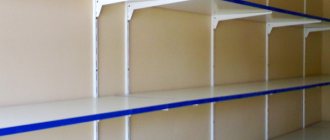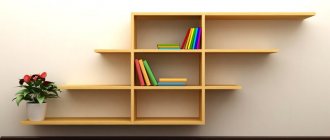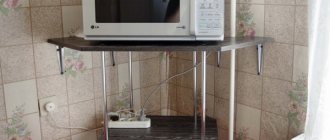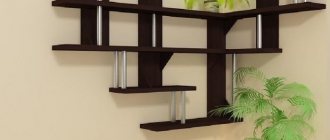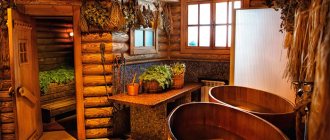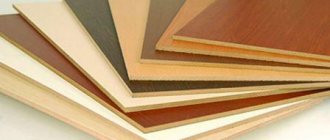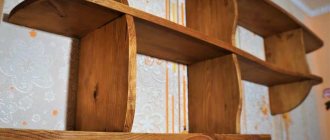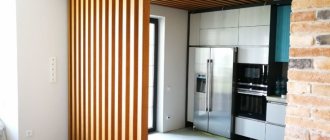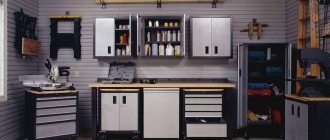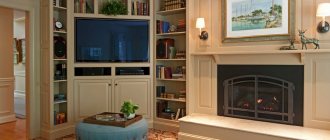Without shelves, which can not only serve as a storage system, but also decorate the interior, it is very difficult to imagine any room. They can have different appearances, all kinds of designs and will allow you to place not only necessary everyday items, but also decorative ones - souvenirs, flowers, flowerpots and much more.
This way the room can be made cozy and beautiful. The most commonly used options are wall shelves; they are not difficult to make with your own hands and at the same time you can not only save a lot of money, but also create a truly exclusive and interesting product.
DIY wall shelves
Types of shelves in the house
Depending on the installation location, shelves can be wall-mounted, floor-mounted or hanging. If the floor shelf has a large height - from a meter and above, it is often called a rack. A few words about hanging ones: usually these are decorative structures that hang on a pipe or a specially driven bracket. This option is popular in rooms where heating pipes run under the ceiling: they just beg to have something hung on them. Shelves are hung on the pipe in the kitchen and bathroom: it’s convenient there.
These hanging kitchen shelves are convenient and functional. You can use the same pipe to make a story made by yourself.
They are made of wood, plywood, laminated chipboard, fiberboard, and there are glass shelves. The same materials are used as stands, but they are also made from metal, plastic and other absolutely incredible things - for example, pipes or bottles.
In living rooms, it is not so important what material the shelf is made of. It is important that its design is in the same style as the interior. Even functionality is not always important: some play a purely decorative role. If they have anything on them, it’s only one or two items. Their role is to give the interior of the home a special style and flavor.
The intimate atmosphere of this room is emphasized by cozy pillows and dark wood shelves.
A laconic style of apartment design and the same laconic shelves in a contrasting color. In this interior they are the main element
The free space above the sofa is organically filled with shelves to match the walls
The shelf can serve as a divider for zones in the room
Light interior in light colors and the same shelves The shape and color of the shelves repeats the shape and color of the table drawers
If we talk about shelves in technical rooms - the kitchen and bathroom, in particular, then in addition to aesthetic considerations, practicality requirements are almost universally added. Even decorative shelves in the kitchen should be washed well. For bathroom shelves, the requirements are generally high: periodically there is very high humidity and materials are required that can withstand it without any harm. There aren't many of them. These are plastic and stainless steel. They also make bathroom shelves from MDF, but they can be used normally if there is good ventilation in the bathroom.
Selection of wood and necessary tools
Wood is practical, versatile, and easy to process. For shelves, novice craftsmen are recommended types of wood with a soft structure (pine, aspen, alder, linden).
When selecting, you need a material with an even outer layer, without deformation. The boards must be well dried, without cracks, voids, knots, or mold damage.
Stands are also made from wood derivatives (chipboard, laminated chipboard). Plywood shelves are economical, durable, and do not require special processing.
The work will require tools:
- roulette;
- table saw;
- sandpaper;
- screwdriver;
- hacksaw or jigsaw;
- grinding apparatus;
- electric drill;
- construction level;
- fastenings (nails, screws, brackets, dowels);
- glue;
- varnish or paint.
Safety regulations require safety glasses and gloves.
Shelves on the wall
In any room there are places on the wall where you just need to hang something. After all, most modern furniture occupies only the lower part - sofas, tables, couches. The upper part remains empty and dissonance arises: the lower part of the room is overloaded and the upper part is half empty or completely empty. These voids on the walls are organically filled with shelves.
The whole system, and the most “dead” space is used - the corner
Structurally, most shelves consist of the actual shelves and lintels. But these components are combined into so many options that it is impossible to count. A simple design is good: you can make any shelves with your own hands. Moreover, these products may be the first self-made things. It's really simple.
How and what to attach it to
It’s not for nothing that we start with fasteners. The design of a wall shelf largely depends on the type of mounting. Or maybe it’s the other way around. It depends on what to dance from...
Traditional hinges
Traditional hinges for hanging shelves
There is a traditional way - on hinges. It is suitable for wood and fiberboard, any other material that is thick enough to attach. Screwed onto the sides with self-tapping screws. Then the distance between the centers of the loop holes is measured and marked on the wall (make sure it is horizontal). At the marked points, holes are drilled for the dowel, the dowel is inserted and a dowel-nail with a small head is screwed into it, which fits into a loop or bracket (a pin slightly bent upward). Then a shelf is hung on them.
Not all materials can be drilled. For example, glass shelves. You definitely can't screw anything into them. Fastenings for glass shelves are special: they consist of two parts, between which glass is inserted. Often elastic pads are installed between the holders. The bottom mount usually has a small clamping screw to secure it in place.
Fasteners for glass shelves
The most popular mount for glass shelves is called “pelican” - for its unique shape. It looks good on its own and is available in different colors. The thickness of glass that it can hold is from 8 to 34 mm. You can insert not only glass into it, but also any other material of such thickness. It just looks stylish with glass.
It’s easy to make glass shelves on the wall with it: you buy a mount, order pieces of glass with processed edges of the required size and shape from a glass workshop (or cut them yourself, if you know how). All that remains is the assembly itself:
- Attach the pelicans to the wall. Two dowels each. The case is collapsible - the decorative trim is removed, and there are two holes in the mounting plate. One is higher in the body, the second is lower. We secured it and put the decorative trim in place.
- Glass was installed.
- Tightened the screw. All.
Holder for a glass shelf on the wall
There are other forms of similar fasteners. The photo below shows a few of them.
Some mounting options for glass (and not only) shelves
Decorative brackets
Another type of fastening is brackets. They are reliable, some are decorative, so much so that they themselves are decorations.
Wall shelf brackets
Concealed installation - shelves without support
And the most amazing device for hidden installation. It makes it possible to hide the fasteners. A seat for the pin and the holder body is cut out at the end, and the shelf is simply put on it.
Hidden fasteners for shelves
As you can see, even a simple board or piece of glass on such mounts is not bad. But there is still a sea of all sorts of ideas.
Read about how you can update old furniture here.
DIY corner shelf made of wood
Corner shelves can be of various heights and have a different number of levels.
Let's consider the sequence of manufacturing a wooden corner shelf from 20x50 mm slats.
- After examining the slats, you need to choose the smoothest ones, with the minimum number of knots - 2 frames will be made from them, measuring 40x70 cm. To make them you will need:
— 4 parts 70 cm long;
- 6 parts 30 cm each.
- It is preferable to glue the frame parts together using clamps.
- Now it's time to make the shelves. They can be done:
- type-setting, gluing together several slats, from which parts of the desired shape are then cut out and edged on the outside with a figured lath;
- from a sheet of plywood;
- made of laminated chipboard. In this case, the cut needs to be sanded and pasted over with furniture edge or in some other way, at your discretion;
- from a fragment of old furniture, if the front part is flat.
- The shelves are screwed to the frames and varnished.
- All that remains is to fasten the hinges and hang the finished shelf in its place.
For a corner shelf, a set of 2 hinges, as in the illustration, is best suited. If you hang the shelf on a loop with a wide eye, then you can then move the shelf along the wall and put on the second loop.
Bookshelves
There are strength requirements for bookshelves: they can hold significant weight. Therefore, the fastening, materials and design must be reliable. Traditionally, bookshelves are made of wood, laminated or veneered fiberboard. And then fiberboard with a long span (more than 90 cm) sag over the years.
When planning shelves for books on the walls according to your own dimensions, keep in mind that the distance between the supports should not be more than 90 cm. Then even when fully loaded it will not bend. There are two types and varieties of shelves: wall-mounted and floor-mounted. Both of them can be angular.
In the simplest case, it is a board secured in one of the following ways. Some options, especially when presented correctly, look very good.
The simplest design of a shelf at the bottom of a wall for books (a secret fastening is used)
And with imagination, several planks turn into a very interesting thing, which can even be the main element of decor. Ideas for DIY are collected in the photo gallery.
And this is a serious way to expand the space due to the corners between two windows
A very interesting idea of using corners for small shelves. Corner wall shelf for books. Attaches to pelicans))
The contrasting color makes this shelf the center of attention.
Nothing complicated: it’s easy to assemble such a bookshelf with your own hands, and the look is non-standard
Nonlinearity - they are always interesting, and on such a shelf you can put books of different heights. Small system with jumpers made of pipes
Floor bookshelves can be loaded more seriously. Here the forms are different: there are racks to which shelves are attached. The highlight can be a broken or unusual line of shelves, as well as interesting racks.
Simple design benefits from color and lintels
Unusual racks adorn this floor-standing bookshelf
This is more like a bookcase or even a cabinet, but the essence does not change - the original color and interesting small shelves in the central part and the structure looks interesting
Easy to make and original
A very interesting idea - non-linear shelves and lintels made of thick glass. This is more of a system of shelves
Read about the manufacture of fountains (both small indoor ones and more substantial ones for a country house, personal garden or garden plot) here.
Advantages and disadvantages of making wooden shelves with your own hands
Wood is the leader in environmental friendliness among all materials. Of course, wooden details in the interior refresh it and bring it closer to nature.
The main advantages of wooden shelves:
- Natural wood, even treated with varnishes and special products, collects much less dust than a product made from any other material.
- Wood is a breathable material that does not emit harmful substances into the atmosphere.
- Wooden parts can be easily processed using tools that can be found in any, even small workshop.
- Wood is a classic material, familiar to the human eye and relatively inexpensive (unless, of course, you use the most expensive and rare types of wood).
- The availability of wood still surpasses all other materials for making shelves.
But for all its advantages, wood also has a number of disadvantages:
- Precious types of wood are quite expensive.
- During production, a lot of waste is generated: shavings, sawdust, bark, etc.
- If poorly treated or not specially treated, wood can leave splinters on a person’s skin when using the shelf.
It is, of course, up to the owners to make a choice about using one material or another, but in this article we will look at several options for making wooden shelves with our own hands.
Hanging
Not very numerous, but an original type. The most important thing is that it can be done easily: a few planks, four ropes or two belts and you can get to work.
Old leather straps can also become the basis for a suspension system
This is a complex system of blocks...and the shelves can be located at any level
Two planks, four ropes and half an hour of time are all you need to make this shelf. How to make a hanging shelf - graphic step-by-step instructions
DIY wooden shoe rack
In a furniture store, shoe racks are not cheap. In order to save your budget, wooden shoe shelves can be made at home. No special carpentry skills are required for this. It's never too late to take on your hallway and build an original shoe rack. For such work, the master uses the following devices: a chisel, an electric drill, a wood saw, a grinder, and a screwdriver. To make a drawing or marks on wood, you will need a ruler and a pencil.
Before starting work, you need to take into account the design of the future craft, its dimensions and functionality. Corner and round designs are the most popular. Most often, ready-made elements purchased in a store are used; “raw” wood is used less and less. In addition to the above tools, you will also need wood glue, metal corners, sandpaper, varnish or paint, and self-tapping screws.
First, the side walls of the required height for the verticals are cut out of the boards. Then the bars for supports and transverse blanks are prepared. Immediately cut out four shoe shelves (elements). All workpieces are processed using sandpaper. The bars are attached to the side walls with self-tapping screws. Metal corners are attached to the end of the product. Each shelf is placed on these bars in turn. When the product is assembled, it is coated with varnish or paint of the desired color.
A wooden shoe rack can also serve as a comfortable ottoman. To do this, the upper part of the shelf is covered with a layer of foam rubber, which is secured with thick fabric or leatherette.
To the nursery
While the child is very small, I want functional shelves, but with children's drawings. But where can you get these? Do it yourself. Any shelf of the configuration you like can be covered with non-woven wallpaper or thick wrapping paper (glued with PVA). After drying, coat twice with water-based varnish. Such shelves can be washed, but what’s most interesting is that the shelf can change with the child. You tear off the old decor, glue on the new one. The idea is simple, it works perfectly.
Here's what can happen
For children, the shelves are not very different in design. If we talk about floor or shelving, then they must be strong, taking into account the fact that older children will definitely want to climb on them. Therefore, often even those shelves that stand on the floor are additionally attached to the wall: so that they do not collapse and crush young climbers. Based on these considerations, they are not made tall: even if they fall, it’s not scary.
The shelves in the children's room also differ in color - they are brighter, can be made in the form of letters, and boxes for toys can be installed in them: this makes it easier to keep them in order. In general, functionality and security must be combined.
System with drawers - cleaning will be quick
Children grow, designs and colors change
A combination of open and closed shelves - convenient for preschoolers. Fairytale town will appeal to both boys and girls
Read about developing a children's room design here.
How to make a corner shelf?
To save space in the house, corner shelves are often used. They look more modern and practical. And note, you can embed them anywhere.
The manufacturing process, in essence, does not differ from that described above, but there are some peculiarities. One of them is that the upper and lower parts are made up of two elements with the ends cut at the desired angle.
Then the process is carried out like this: first, the two parts of the top are glued together and clamped for a while. Do the same with the bottom beam. Polish, cover with a primer mixture and fasten according to the algorithm written above.
That's it - the work is almost the same, but a new, convenient, practical product is already appearing.
Shelves and shelves for the kitchen
Say what you like, but in the kitchen the main thing is functionality. There is not much free space even on the walls: the cabinets take up a large area. Therefore, one of the tasks is to make the most of free space. There are interesting ideas for small or even very small gaps between the wall and the refrigerator or other household appliances. Strictly in size, you can make a pokka on wheels, which can be pulled out and completely hidden there. It is wide and narrow (see photo).
It’s easy to make such a retractable shelf-rack on wheels for different jars. Everything you need is at hand and out of the way
There are also interesting ideas for saving space. If the sink or station is located near the window, you can take the sides. There is an interesting hanging option - a grid on chains to which all sorts of utensils are attached. But such a shelf is possible if the desktop is not against the wall. Another option for saving space is if the kitchen-dining room is zoned with a counter, you can also make a shelf above it, which will be partially hanging. One part of it rests on the wall, the second on the counter or “hangs” on the ceiling.
We take up all the free space
Shelves near the window in a different style
Hanging shelf for small items
There is also unused space above the counter.
Read about ways to arrange kitchen furniture here.
Covering the entire wall above your desk with cabinets is not the best solution. They look heavy. The problem can be solved by using glass doors, but not everyone likes this. The solution is to make open shelves between the cabinets. They will add more lightness to the interior and the work area will not put so much pressure on the rest of the space.
Glass and open shelves will “lighten” the interior
Stylish accessories don't hurt
There's room for glasses too. Different style, same idea.
Closed and open shelves in one system - convenient and non-standard
How to make a simple wooden shelf?
If you add different numbers of modules you need to the base, you can easily give it a completely new look. Please note that you need to look at the condition of your materials - they should not be crooked, cracked or covered with fungus. And if everything is ready, you can start creating the shelf.
Step one. Marking. For example, let's take a rectangular shape. We take a pre-prepared drawing of the structure and transfer the measurements to the boards. When we have completed this stage of work, we proceed to the next one.
Step two. Sawing. A jigsaw is best suited for this, but other tools are not excluded. Make sure that the cuts correspond to the markings. The result should be two short and two long boards.
Step three. Treatment. The prepared blanks must be processed. Sand each element, cover it with stain and varnish. Then the design will serve you longer.
Step four. Assembly. Place the bottom horizontally. We mark eight millimeters from the edges and then draw lines. Please note that they must be parallel to the cuts.
Next, on the drawn strips we mark the places where the holes for the screws will be made. Same with the top. After this, side boards secured with self-tapping screws are attached to the lower part of the product. Place the top board on top and secure it.
This is the simplest version of a wooden wall shelf that you can make. And you can build on it when constructing new products.
Decorative and original
Often, shelves on the wall play a purely decorative role. They are designed to attract attention and this goal is achieved by an unusual shape, contrasting with the walls and color. You can’t bet much on it: one or two things, but how interesting they are.
There are only three rectangles, but due to the color and binding they look very stylish
Another option made from different rectangles and squares, and even painted in bright contrasting colors. You won’t pass by. Very interesting idea of using corners for small shelves.
The theme is the same, the mood is different. And only due to the fact that the contrast between the color of the wall and the color of the shelf is not so bright. Another option for “square” shelves. Two identical sets arranged differently
If traditional square shelves are decorated around the edges with curly frames, the style turns out to be completely different.
Another interesting topic is glass shelves. Just one glass is not very interesting. Its combination with wood and steel is more attractive. The effects are sometimes unexpected. Glass is assembled on guides: the material is fragile and heavy, and it needs to be held. Steel can do this.
An interesting glass option. You can arbitrarily change the height between tiers
In fact, these systems are intended for creating store interiors, but they also look stylish in an apartment in a modern or loft style.
Also suitable for vintage style
What are shelves made of? Even from pipes. Metal and plastic. Do you have any samples left from the renovation? Put it to work and get a designer item, interestingly, assembled from trash.
This is a floor-standing option
Plastic pipes do not need to be painted. Water pipes, corners, everything is painted with bronze paint. Large diameter plastic pipes installed in a frame. Here's an unusual shelf. Here's an interesting variation of a bookshelf made of pipes
There are examples that simply amaze you. Well, how could you come up with this?
A combination of open and closed shelves. Non-standard shape - rounded corners and a completely new look
The forged base looks noble
Custom corner shelf
Can be an interesting partition between zones
Something similar can be made from polycarbonate. They come in different colors and bend well
The author's wild flight of fancy
Idea for those who have a lot of books
Interesting design
For lovers of cut flowers
Cardiogram shelf...
General recommendations
Beautiful shelves will find their application in any room of the apartment, be it the kitchen, living room, bedroom, hallway or bathroom. With their help, the room will look more lived-in, interesting, and there will be additional space for storing any useful items.
First, decide for what purposes the wall structure will be used, this will help you not to make a mistake with the required dimensions and strength of the device.
A shelf for heavy objects, for example, books, an aquarium, collectible dishes, potted plants, should be as reliable as possible, made of solid materials.
You can find a large assortment of wall shelves at attractive prices in the First Furniture store.
A shelf in the bathroom for storing various cosmetics and bath accessories may not be so strong, but be sure to keep in mind that the materials for its manufacture must be moisture resistant.
If the wall shelf will be used only as an original art object for interior decoration, to perform the function of decorating a room, and objects and things are not expected to be displayed on it, then for its construction it is permissible to use any, even the most fragile, materials.
Therefore, before starting the process of designing a shelf, be sure to consider the following details:
- full load on the structure;
- fastening method;
- compliance of the materials used with the purpose of the room in which installation is planned;
- product style and design;
- functional.
Shelf drawings
Basically, the designs are simple: you look at it and have a rough idea of how it should be done. For those who want to make shelves with their own hands, here are a few drawings. Having them on hand, you can easily make the required changes in size. Just remember that from fiberboard with a thickness of 16-18 mm, the span between the supports should be no more than a meter, or better yet, 90 cm. Otherwise, there will be a deflection. The situation is approximately the same with plywood.
The only thing that may be unclear is how to assemble some nodes. Let us explain with one diagram; the rest of the assembly is similar. All connections are made at the corners. To make the structure reliable, the shelves are cut out intact, and jumpers are attached to them at the corners.
All these connections are made at the corners
The corners are installed from below, two for each connection on the right and left. They are made from metal or plastic. If the load is planned to be significant, install metal; if the shelves are decorative, you can use furniture made of plastic.
Some types of corners
Now you can make your favorite wall shelves with your own hands (and floor ones too).
Hinged design for spices on belts
The kitchen space requires compact stands for herbs, cereals, and spices; The spice rack is made according to standard drawings or an original design. You will need 1-2 boards, laminated on the outside, and steel fittings for a hanger. Plywood spice racks are a budget option.
After measuring the dimensions of the shelf, the boards are marked and cut. The elements are connected into a single structure using an adhesive base. It is necessary to secure the parts of the shelf with clamps and leave them to dry for 12 hours. The elements are additionally connected with self-tapping screws. The boards are sanded and painted.
A hole for fastening is drilled in the wall or ceiling surface, and the hook or bracket is secured with dowels. Ropes or belts are pulled into special openings. The homemade spice rack is adjustable and fixed at the desired height using a dowel.
Small furniture forms in design
Each shelf, regardless of shape and design, performs the same functions and is used for practical purposes.
The photographs presented in a wide variety allow you to appreciate the variety of design and original structures that are used in the interior of the premises.
This is not only a decoration, thanks to which the wall does not look empty, but also a multifunctional piece of furniture that performs several useful and practical functions at once:
- visual decoration of space and emphasizing the idea of an original stylistic solution chosen for a certain type of room;
- emphasis on exclusive interior design, which is possible when choosing non-standard configurations with a wide variety of product types;
- the use of shelves is also possible when carrying out subject zoning of the free space of a certain room in an apartment, house or office;
- organizing simple and convenient storage of small items, souvenirs or a collection of books; flowers, photographs, paintings can be placed on the shelves;
- comfortable and safe placement of digital equipment regularly used for practical purposes, this could be a TV, alarm clock or speakers.
Any chosen idea that is implemented for the purpose of creating shelves must be implemented on the basis of certain principles.
The home craftsman should not only choose the right project and draw up a sketch, but also choose the right materials from which the shelf will be made.
In addition, the work will require the simplest and most affordable tools and additional accessories for finishing, durable and reliable furniture fittings.
How to make a corner shelf?
To save space in the house, corner shelves are often used. They look more modern and practical. And note, you can embed them anywhere.
The manufacturing process, in essence, does not differ from that described above, but there are some peculiarities. One of them is that the upper and lower parts are made up of two elements with the ends cut at the desired angle.
Then the process is carried out like this: first, the two parts of the top are glued together and clamped for a while. Do the same with the bottom beam. Polish, cover with a primer mixture and fasten according to the algorithm written above.
That's it - the work is almost the same, but a new, convenient, practical product is already appearing.
How to make a simple wooden shelf?
If you add different numbers of modules you need to the base, you can easily give it a completely new look. Please note that you need to look at the condition of your materials - they should not be crooked, cracked or covered with fungus. And if everything is ready, you can start creating the shelf.
Step one. Marking. For example, let's take a rectangular shape. We take a pre-prepared drawing of the structure and transfer the measurements to the boards. When we have completed this stage of work, we proceed to the next one.
Types of fasteners
The classification is made taking into account the location of fastening devices on the shelf.
Shelf fasteners differ not only in appearance, but also in location
Hidden
Due to hidden fixation, it is possible to save free space on the wall and fill it with other necessary elements. The hidden fastener is completely invisible, it is mounted on the back of the shelves, and can be installed on vertical or horizontal parts. There are hidden elements located inside the shelf frame; before installing them, it is necessary to carry out special preparatory work.
- Suspensions (hanging loops). Traditional fastening, used for shelves made of natural wood, OSB boards, plywood, chipboard, etc. Not suitable for glass, plastic and metal products.
The hinges are fixed into specially made recesses, their dimensions do not protrude beyond the perimeter of the shelf, and after fastening they become invisible. Concealed hangers - Consoles (rods). A more modern type of shelf fixation, used for the same materials as hinged hinges. Secret holes are drilled in the shelf frame into which rods (consoles) are inserted. The fasteners are metal, the outer surfaces are covered with plastic, and in terms of strength and reliability it falls into the middle category. The fact is that as a result of drilling a hole, the thickness of the load-bearing element is reduced by two or more times, and this has a negative impact on mechanical stability.
Concealed fastener made of metal plate and rods
Concealed fastening with timber
Open
These elements are always noticeable; thanks to original engineering solutions, it is possible to redistribute the loads and increase the stability of the shelves. If in the above listed options for hidden fasteners, the loads act only on the dowel or console, and they are pulled out of the wall due to the moment of rotation, then the corners and brackets do not work that way. They remove most of the load from the dowels and transfer it to the wall due to the curved stop. The original design of the brackets becomes a real decoration of the interior; such fasteners can be used for all shelves without exception, including glass ones.
The brackets also perform a decorative function.
